WWVets.com
The US Marine Corps the Great War
The Marines earned their nickname “Devil Dogs” from the Germans in WW1 at the Battle of Belleau Wood. They used 1903 Springfield Rifles with such effective marksmanship that they decimated German troops from a distance of over 800 yards.
The marines had 9,063 casualties with 1,063 battle deaths in the 31 days of constant fighting at Belleau Wood that finally ended with an Allied victory on June 26, 1918.
The 6th Marine regiment led an attack on July 19th to protect the Soissons-Chateau-Thierry Road with insufficient artillery support and little concealment resulting in a 50% loss of the attacking 1st Battalion, forcing them to dig in to wait for reinforcements.
The Second Division including the 4th Marine Brigade was placed under French Marshall Ferdinand Foch and succeded in breaking the German line.
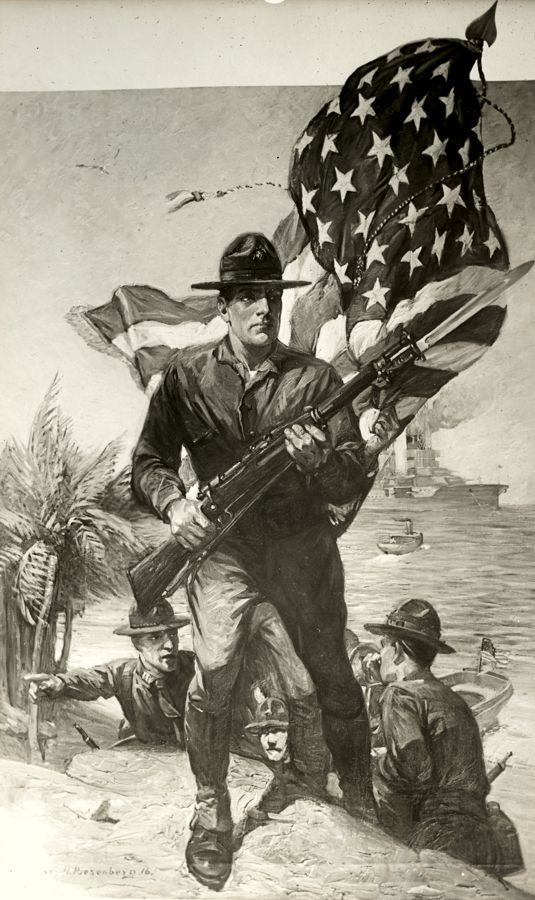
1917 Recruiting Poster by Sidney H. Riesenberg
National Archives 165-WW-459A-4
Veterans stories:
Leslie Albert McPike,
Co C, 8th Machine Gun BN
Lawrence County, Indiana
Distinguished Service Cross:
Bois-de-Foret, France: "Having been sent with his section to defend a difficult position, Sergeant McPike succeeded in breaking up a hostile counterattack, though his ammunition was exhausted in so doing. Shortly afterward, when another counterattack was made against him, he and his men held off the enemy with their pistols, though at one time the Germans had closed in from three sides. Their courageous stand checked the enemy until fresh ammunition could be brought up, whereupon the hostile attack was completely repulsed." Nantes, France: ...Sergeant McPike maneuvered his guns so successfully that he lost neither man or guns, though his original positions and the surrounding fortifications were completely destroyed..."
William Klamm, Marine Corps
Lake County, Indiana
Silver Star:
"...though wounded and with a practically disabled automatic rifle, continued to keep his piece in action and refused the aid of his comrades in order that he might fulfill his duty."
Ernest Franklin Hess, USMC, Gunner,
Ripley County, Indiana
Wounded at Belleau Wood. Struck in the left thigh, both arms and left eye. Hospitalized for five weeks to recover and fitted with a glass eye.
Came over in a Hospital ship in a Casual Co. We sent on arrival to the Naval Hospital at Portsmouth, Virginia for two months. Was sent to the Marine Barracks at Norfolk Va. for one month.
Served as a gunner on an outpost when wounded at Belleau Wood, June 23, 1918.
Service in the trenches at Verdun consisted of raiding, extending excavations of trenches, and building roads. Was under constant shellfire and subject to gas attacks almost every night.
“Had only a week’s rest after the Verdun trenches until sent to Chateau-Thierry. Advanced eight days in this attack, doing hand to hand fighting with nets, rifles and machine-guns. (French ‘sho-sho’ guns). Marched back for rest when relieved by 7th Infantry. A barrage was put over the first night after this relief. The 7th Infantry fell back, the Germans rushed in and retook all the Marines had gained in the eight days. “The 6th Marines were sent immediately to relieve the 7th and went again into a battle about 8 or 9 AM, June 2, 1918. They succeeded in retaking Belleau Wood, advancing four kilometers. They continued the advance for twenty-odd days until the entire wood was taken and held.
“Private Hess carried a wounded Lieutenant from a hill in Belleau Wood to a First Aid station in a ravine. The Lieutenant was then carried by the First Aid men to a Field Hospital. Both of these men received medals for this action. Orders to all marines were to drag wounded out of further danger, so this action was in the line of duty. Nearly all soldiers served their comrades in this way.”
Victor Keenan Baughman, 5th reg., USMC,
K. I. A.
Grant County, Indiana
Wounded by shrapnel October 4, carried to field hospital #15 and died October 6, 1918, Battle of Blanc Mont Ridge.
General Gouroud, in proposing the citation of the 2nd Div.
‘On October 3, this Div. drove forward and seized in a single assault the strongly entrenched German positions between Blanc Mont and Medeah Farm making in the course of the whole day, an advance of about 6 km.
It captured several thousand prisoners – This attack resulted in the evacuation by the enemy of his positions on both sides of the river Suippe.
In this fight, and in the week of advancement following, the casualties amounted to 95 officers and 2,369 men in the 4th Brigade of the Marines alone, of whom only 31 men were reported missing.
Victor K. Baughman was the son of John A. and Ella McNair Baughman and was born in Marion, Indiana.
The following is a letter received from the soldier who buried him.
Bendorf, Germany, March 5, 1919:
Dear Sister; Since receiving your letter of February 5, asking me to try and give further particulars of the death of Victor K. Baughman, I have made mental and clerical research with good results.
If I told you that I secured the little manual from a boy in the Argonne, I was mixed up. Here is the way I secured it. I was on burial detail. On bearing a body, the pockets were emptied of money and valuables and these were sent home. When we buried this lad, instead of leaving the minor trinkets and papers in his pockets, as usual, I took the little book as a souvenir.
Victor K. Vollman, serial # 42604357, Private, 51st Co., 5th Marines, wounded by shrapnel in the left knee and abdomen, at the Battle of Blanc Mont Ridge, October 3-4, carried from field to Field Hospital #15, where he died on the sixth of October, 1918. Buried in grave #97, in the little cemetery we started near Suippes, (near Chalons).
I helped bury him. He was buried in a blanket and his uniform worn when wounded. Service was read by a chaplain and taps blown. We buried five others at the same time. The Blanc Mont Ridge Battle remains a highwater mark in the history of American valor. The French foreign Legion failed to take it; the 2nd Div. did not fail.
Suippes is situated out from Chalons.
Jack Holdcraft
Wounded Marine receiving first aid in the trenches
National Archive photo 12151 Group 111
Courtesy Indiana War Memorial Archives
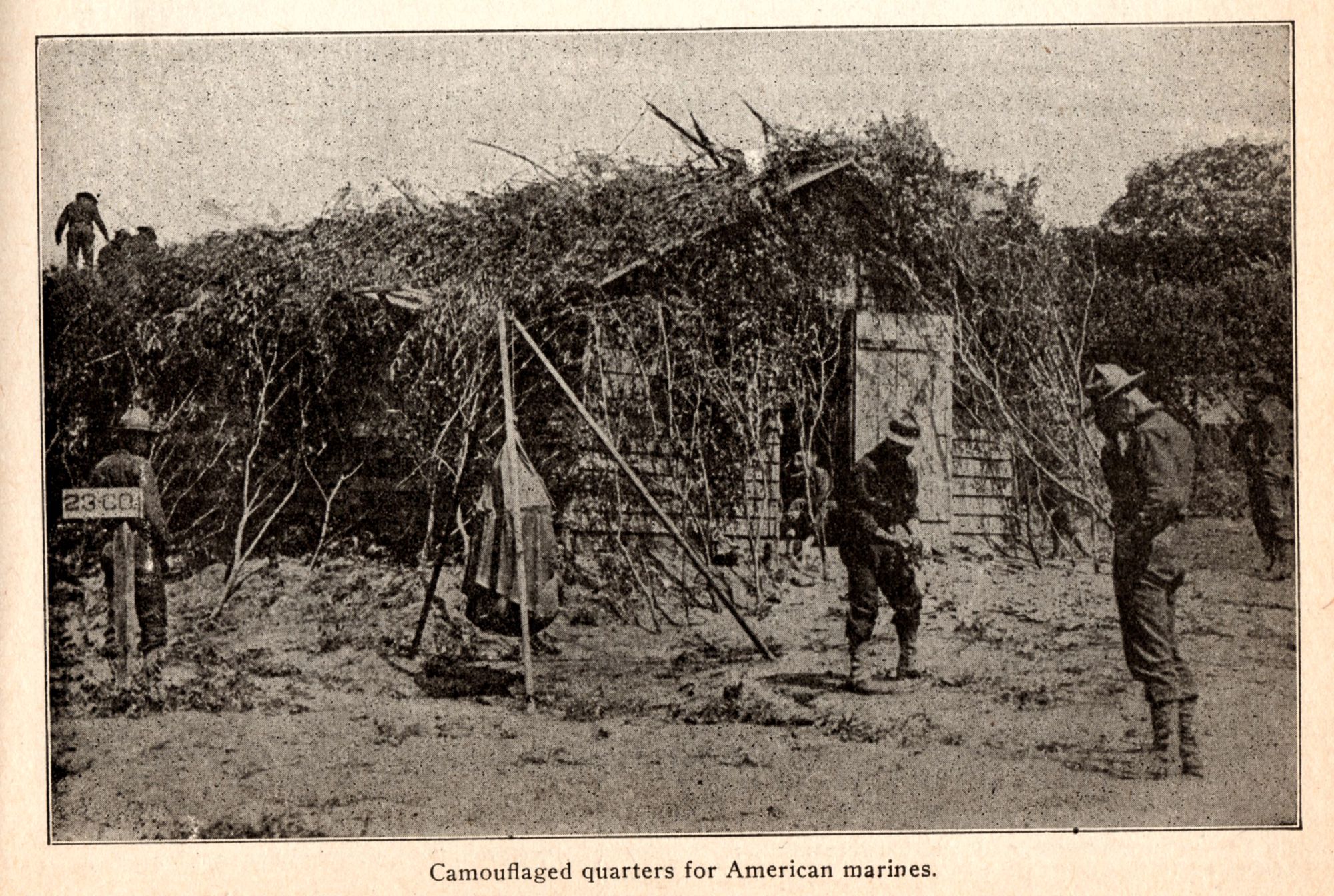
"Camouflaged quarters for American Marines"
National Archives Photo
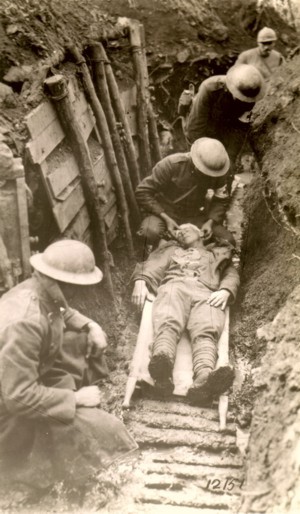
Joseph Cyrill Coffee, Distinguished Service Cross, Allen County, Indiana, Pharmacist Mate, US Marine Corps, U.S. Navy
Transferred from Navy to first aid detachment of Battalion 1, 5th Regiment, US Marines early in June 1917 and sailed the same month from Philadelphia for St. Nazaire, France and upon arriving unit underwent six months of intensive training.
Coffee was one of a group of 15 men transferred to the Marines at the same time, he was appointed Pharmacist Mate.
Battles: Verdun Sector, Paris-Metz Road Sector, Belleau Woods, Soissons, St. Mihiel Salient, Champagne Sector, Argonne Forest and Meuse Valley.
Awarded the Croix de Guerre, the under being bestowed by the French, General Pershing, on the 21st of March, 1919, at Walbricht, Bach, Germany. Coffee was also recommended for the Distinguished Service Cross, which had not yet been conferred when the young man visited Ft. Wayne on furlough.
Joseph Coffee held the rank of Pharmacist Mate in the Navy previous to transfer to Marine Corps, in which he was in member of a first aid detachment of 15 men, of whom he is the only survivor.
On two occasions he displayed so fearless a type of bravery as to the awarded the honors mentioned above. On June 6 in the Defense of the Paris, Metz Road, Coffee repeatedly crawled out into a wheat field, under a rain of machine gun bullets, to bandage in injured comrades wounds and drag him to a place of safety in the woods, continuing the work until the guns were silenced. The citation* reads: Pharmacist’s Mate Joseph Coffee, of Ft. Wayne, Indiana etc., etc. as preceding… In the fighting in the Champagne sector, from October 1-11 occurred the acts for which the Croix de Guerre was conferred, the citation reading “For extreme bravery under fire”. The section was unusually hazardous, and Coffee and two comrades went out to care for wounded, under a raking fire of machine guns, and exploding shells. They carried a Red Cross banner, but the Germans paid no respect for the sign of mercy. The other brave lads were killed, but Coffee escaped miraculously in his rescue work, and returned uninjured from his trips.
The Battalion to which young Coffee was attached, entered the trenches in the Verdun sector, March 4, occupying until late in May when they were relieved by other troops. This is the only period during which the 5th Marines were protected with real, improved trenches. Everywhere else the shelter from fire was roughly improvised. On the Defense of the Paris Metz Road, the unit lay underneath cover three days, emerging on the 6th of June and chasing the Boches for six kilometers.
The Regiment held the frontline in Belleau Wood until July 5 and from there went to Soissons and over a series of trenches, as shock troops. After three days fighting, they were given a brief rest, and then assigned to the participation in the St. Mihiel Drive, the Regiment being on continuous duty for eight days. From October 1-11, Coffee was attached to a division holding the Champagne sector, this being the place where his bravery won him the Croix de Guerre.
When mustered out, July 20, 1919, Joseph Coffee had served four years in the Navy and in the Marines. An extreme modesty distinguished the young man's behavior put on furlough, and he preferred to tell of a comrades bravery rather than speak of his own acts. Only one other Ft. Wayne boy is known to have won both crosses.
*this was the citation for the Distinguished Service Cross.
Pvt Dean Francis Smiley, Distinguished Service Cross, Elkhart County, Indiana
October 9th, 1918 He rushed to a hostile machine gun nest single-handed, killing three of the crew and capturing the remainder. While taking his prisoners to the rear, this gallant soldier was killed by enemy artillery fire.
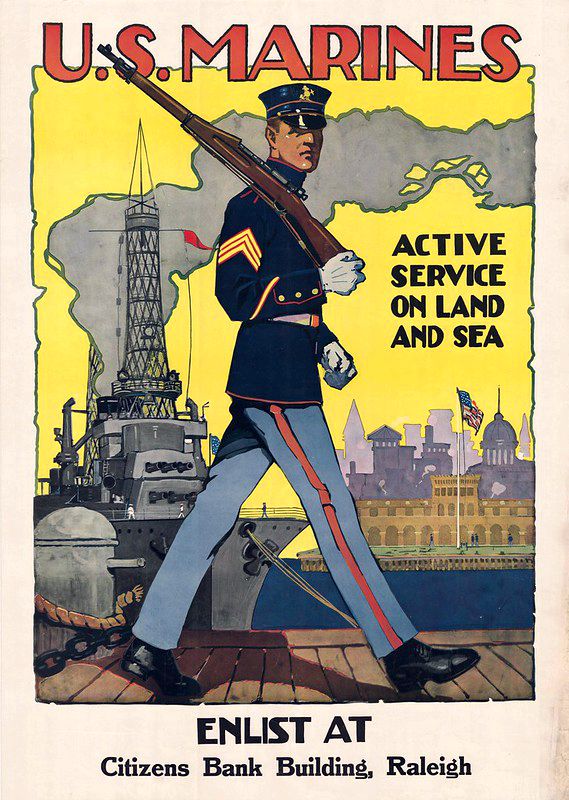
The following is an excerpt from the Sons of Men, Evansville's War Record, (source 41)
"THE LUCKY FIVE
"The name 'Lucky Five,' is a result of the induction of men into the United States service in the city of Evansville, Indiana, and designates a fighting quintet of soldiers which was represented in two branches of service the Marines and the Infantry. They were members of the Glass Bottle Blowers Association of the United States and Canada and were employed at the Graham Glass Company as a secretary when they entered the bloodiest of all wars. Since their early childhood, they have been closely associated, and for many years they worked side by side at the Graham factory.
"When the war ended the only one of the 'Lucky Five' who did not come back was Ernest James Osborne, the Marine. He was Evansville's second Marine to give his life in battle and earned for her the third Goldstar.
"Osborne was the son of John F. And Josephine Osborne. He was born in Loogootee, Indiana, on July 3, 1895. He was a graduate of St. Joseph's parochial school there and was attending high school when he took up the glassblowing trade. He was finally transferred to the headquarters of the Graham Glass Company in Evansville, where he remained until he enlisted May 22, 1917. He was given military training at Port Royal, and Paris Island, South Carolina, and at Quantico, Virginia, and was assigned to the 80th Company, Second Battalion, Sixth Regiment, US Marine Corps, AEF. He sailed for overseas service on January 1918. By April he had taken part into sharp engagements with the enemy. He qualified as a sharpshooter and was one of the machine gun squad. He made a good record as a soldier and was proud of being a Marine. He carried out the traditions of the family, as his father was a Civil War veteran and had served in Company G, 10th Kentucky infantry. The young Marine was killed in France June 3, 1918, (just one month to the day before he would've attained his 23rd birthday), while in the thick of the fight in which the Marines drove the enemy from their footholds just northwest of Château Thierry near the Marne. Their bold dash at the German forces prove fatal to him, but he fell a hero while gallantly fighting and pressing forward in the last of a series of victories of the daring Marines.
"In his last letter from the trenches dated May 16, 1918, he strangely forecasts the drive of the Marines on the German lines, when he said, 'Wait until we Americans make our drive, then there will be a change. The enemy will soon be through with their drives forever. ' The next news of him was a dispatch from overseas which contained: Ernest James Osborne killed in action. He had finished his fighting on the battlefield near Martin, and his steering Marines body now lies in the American Cemetery Commune Essommeres-Sur Marne, Aisne, France."
WW1 Marine Recruiting Poster
US Signal Corps
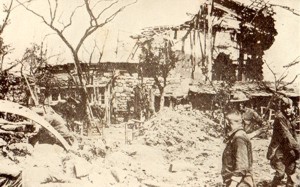
"Chateau-Thierry after the battle that brought undying glory to American arms and especially to the Marine Corps."
America's War for Humanity
WW1 recruiting poster US Signal Corps
Photo: Sydney F. Schafer, Pvt,
Marion County, Indiana
Served in Hattiesburg, Mississippi
Marion County in the Great War,
Indiana State Library Archives
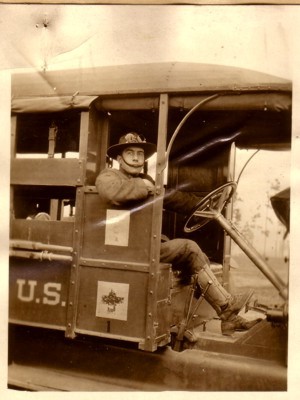
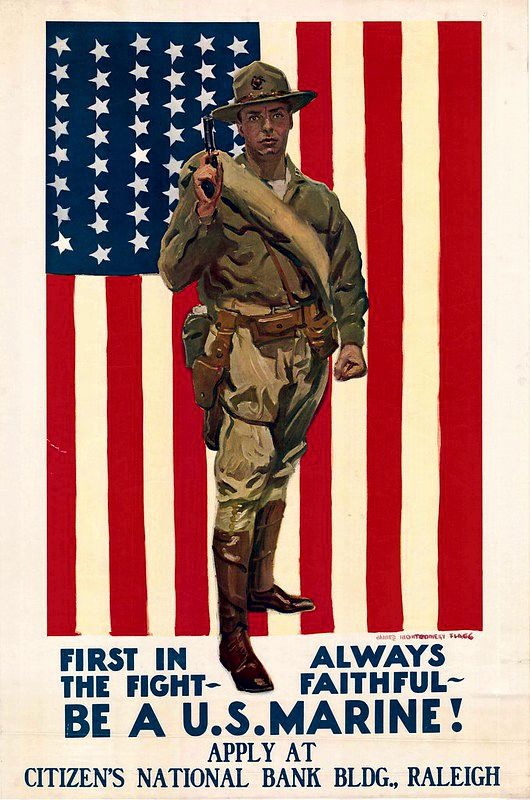
Merrill Robert Rhodes, USMC, Wounded, Gibson County, Indiana
M. R. Rhodes, a marine invalided from France, whose home is in Winslow, is in the city visiting the family of Dr. A. H. Rhodes in W. State Street. Rhodes, a stout looking fellow, was in France for eight months. He took part in the battles of Belleau Wood and Chateau-Thierry, where the American Marines gave the Huns the blow that won the war for the allies. Soldier Rhoades stated today that of the 8000 Marines who took part in the battle of Chateau-Thierry, more than half came out casualties, but only 47 were captured by the Huns in the entire battle.
Soldier Rhodes was in the front-line trenches for two months. He fought from July 2 to July 26 and on the 26th he was shot at the top of the head. He was in a hospital until November 11, the day of the armistice signing and sailed on that day, arriving in the United States on November 21. Although the wound in the head has healed considerably, there is yet a large hole left in the top of his head.
He wears a service stripe and a wound stripe on either sleeve. He will report at Portsmouth, Virginia in a short time when he will receive his discharge from Army service. Princeton Clarion-News, Monday, December 17, 1918, p4, c6
Frederick Tutewiler Evans, Corporal, USMC, Marion County, Indiana
His transport ship, USS Henderson burned at sea during his trip to France. Crew rescued, landed at Brest, France. He is also listed in the Shortridge Daily Echo, Dec. 18, 1918, a listing of graduates from Shortridge High School, Indpls, Indiana in military service.
William Alpheus Kreuzman, Navy Cross, USMC, Ripley County, Indiana
“Paraded in Linden and Paris while overseas and before rulers and Generals of practically all Europe. Paraded in New York City, September 10, 1919, and Washington D. C. September 17, 1919.
“The Agamemnon and Von Steuben collided in crossing to France, October 1917, in mid-ocean. Struck front of ship 6 PM, November 6. Guns were misplaced and lifeboats destroyed on one side of the ship. The watertight compartments of the Von Steuben prevented sinking. Crew and Marines on board wore life-belts for the rest of the trip, six days.
Charles Samuel Gibson, USMC, Ripley County, Indiana
.was selected with Will Kreuzman of the same Company and regiment and the same home town, as members of Pershings Composite Regiment, May 2, 1999.
"In Paris, July 4th to July 14. 1919 at Pershing Stadium, drilled and paraded before different kings, generals and presidents, etc. of France, Serbia, Montenegro, Sczecho-Slovakia, etc. Paraded in Linden, July 19, 1919. Received on July 18, by Prince of Whales. Paraded in New York, ptember 10, 1919, and in Washington D. C., September 17, 1919."
Your content goes here. Edit or remove this text inline or in the module Content settings. You can also style every aspect of this content in the module Design settings and even apply custom CSS to this text in the module Advanced settings.